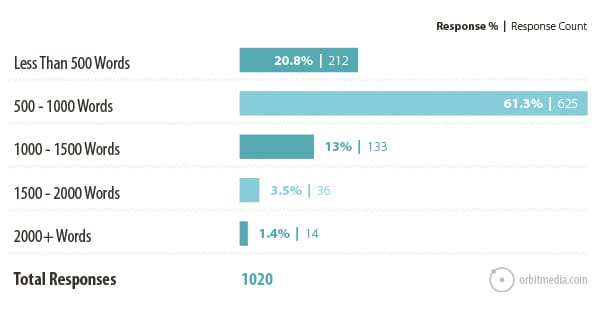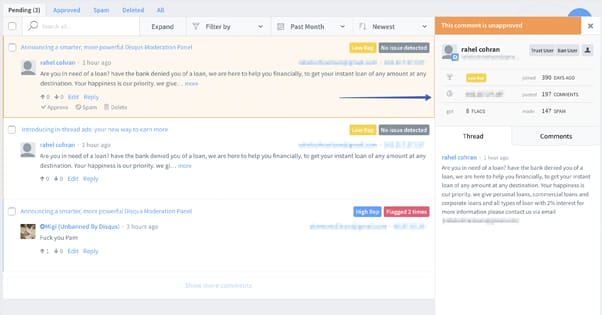How Comments Can Improve Your Blog Post Rankings and Traffic
Published by Kenny Novak • Content Marketing • Posted September 7, 2017 ContentPowered.com
ContentPowered.com
In the constant quest to improve search rankings, we bloggers look high and low for any advantage we can find. Yet one constantly debated aspect of blogging lies dormant, abused or neglected by bloggers and readers alike.
Blog comments can be extremely beneficial for your SEO, and in ways you might not expect. But first, you need to write content that is good enough to warrant people commenting on it.
The Core Principles of Good Content
Good blog content should, in my mind, adhere to three main principles.
- It should be long enough to hold reasonable value.
- It should help the user accomplish their task.
- It should be formatted for quick reading.
What do each of these mean?
The first is pretty simple. A short piece of content doesn’t have space to fully dive into deeper topics or cover all the bases. Rather than leave the reader informed, or leave the reader asking questions for further discussion, it leaves them feeling unsatisfied. It’s like the junk food of blog writing; it might fill your stomach but it doesn’t do you much good in the long run.
I generally recommend at minimum 1,500 words for your posts. I personally aim for closer to 2,000, and have seen a noticeable increase compared to when I was blogging with posts only 1,000 words in length. You can go longer, but often times anything over about 4,000 words has diminishing returns. Either you end up needing to fluff a lot to reach your higher counts, or you drone on too long about a topic that is adequately covered in less space. Generally, a post that long can be broken up into two posts of greater combined value.

That said, follow your heart and your mind when it comes to content length. If you reach 1,800 words and find you can’t figure out how to keep going, then don’t. If you reach 2,200 words and find you still have more to say, say it. You can always split a lengthy article later, but publishing a sub-par article can be detrimental.
The third is also pretty simple. You want shorter paragraphs with shorter sentences in them. You want frequent or semi-frequent bullet points and lists. You want to bold, italics, or underline key points, though you shouldn’t go overboard to the extent that you look like a spam site. You want links for expanded information and citations, and you want images to break up your content frequently. I admit I don’t always hit every point here, but I do pretty well.
No, I didn’t skip the second; I saved it because it’s the most complex of the three. It requires knowing a little about the psychology of search.
When a user goes to Google – or says “OK Google” or otherwise activates voice search on their smartphone – they’re coming into it with a task in mind. Either they want to do something specific, or they want to learn something. Sometimes they want to learn what kind of products fill a role. Sometimes they want to know how to replace the RAM in a computer. Sometimes they want to know how to balance a budget. Sometimes they want to view the latest Taylor Swift single. Regardless, behind every set of keywords is an intent.

People have an intent that is generally either to do something or to learn something. Therefore, every piece of content you create should be composed to help them do something or to teach them something. You want to write the article about how to replace RAM. You want to write the guide to a certain type of product. You want to, well, you’re probably not going to rank for anything T-Swift related, but you could always try.
What does any of this have to do with blog comments? Well, the number one thing you need in order to GET blog comments in the first place is great content. No one will come and leave a comment on a mediocre blog post. Hell, hardly anyone leaves a comment on a good blog post, compared to the amount of traffic it gets.
How Blog Comments Help
When you have excellent content and can get comments, you can start to see the many different ways they help to boost your SEO.
First of all, you have the mechanical benefit. Blog comments mean people are interested in your content enough to leave a comment. Either they’re thanking you for the content, or they’re asking you a question, or they’re disputing a fact, or they’re adding their own argument to bolster yours. In every case, except maybe the first, it means they read your content. It’s a great sign of a great, more engaged community, and building a community is the first step to building something great.

When people comment, you are able to help bring them into your fold. You can continue a discussion, you can add their context to your post, you can expand upon what they’ve said or debate them. You can work to keep them engaged moving forward, and you can engage with them on other sites, like Twitter. If they’re content creators themselves, you might even be able to strike up a mutually beneficial relationship, with linking back and forth, discussing projects, and generally networking with each other.
Through blog comments, you can also discover interesting content you might not have seen before. Maybe someone leaves a link to a site that disputes your core point, or would be useful to add to your list.
Allowing links in your comments, particularly followed links, can be dangerous, of course. It can hurt your SEO to be one of those link dumps where spammers throw their links just to leech off your popularity. However, with proper filtering and a plugin that helps monitor for spam, you can encourage comments and links without opening yourself up to a penalty.
There’s one way that blog comments boost your SEO more than you might realize, though, and that’s through their content.
If you have 10 people leave 100-word comments on your post, that’s an extra 1,000 words of content on your page. If you have a 2,000-word blog post, that’s 50% more content, for free. You didn’t have to write it, and since it’s on the same topic, it’s relevant. It brings in keyword variation, it brings in more value, and it can associate high profile author names with your content as additional contributors, however minor an influence that might have. If you have 20 comments of that length, it’s double your content.
On some posts on major blogs, like Neil Patel’s various offerings, he can have five or six times the content of the post in the comments, if not more. That’s a heck of a lot of free value!
If you’re not sure whether or not this actually causes an increase in SEO value for your site, feel free to do an experiment: just temporarily disable your comments, for a couple weeks, and look at your rankings across your content. You don’t even have to do it for your whole site, just disable comments for your best few posts. I bet you’ll see a pretty big drop in ranking. For corroborating evidence, ShoutMeLoud also noticed this phenomenon and wrote a post about it.
How to Make Blog Comments Work For You
Not all blog comments are good. In fact, many comments can be actively harmful. There are three phases to the comment improvement process, and I’ll guide you through each of them.
Phase 1: Auditing. The first thing you need to do is audit the blog comments across your entire site. The way I see it, there are three categories of blog comment.
- Spam comments. These are pretty obvious. Some account with no picture and a garbage name comes in and leaves a comment unrelated to your topic, with a few keywords and a link to some spam site. Even the default spam filters will catch these, but now and then some of them will slip through.
- Valueless comments. These are the people who swoop in and leave that ever-ironic “First!” with nothing else. It’s the people who drop a “thanks for writing this, it gave me a lot to think about.” They’re all comments that don’t add anything to the conversation, don’t open up a conversation of their own, and look like fluff to Google.
- Good comments. These are the people who ask questions, who start discussions, and who add value through links and through suggested content. These comments are the absolute best you can get; they add SEO value, they give you a place to start a conversation, and they help you out on every front.
The first step, then, is to go back through your entire site and audit all of the comments on every piece of content that has been published. This is going to be extremely tedious and time-consuming, but worthwhile when all is said and done.

What should you do with comments? On any post over a month old, provided it does not get traffic or new comments, I recommend removing anything from category one or two. Be harsh about it; those people aren’t coming back to call you out on it, and you won’t lose anything by removing them.
On posts that are newer or that still have activity – like evergreen tutorials or viral content that keeps getting circulated – you will want to remove category one comments with extreme prejudice, but can leave some category twos depending on their contents.
I’ll mention what to do with category two and three comments in phase three.
Phase 2: Reinforcement. The second phase is to reinforce your blog comments against spam. How you do this depends on your current setup, but here are a few ideas:
- Consider switching your comment platform. There are a lot of alternatives out there, some of which have a lot of nice features compared to the default comment system on WordPress. Some comment systems have much better restrictions, like Facebook, which minimizes spam by making people have Facebook accounts. If you do choose to change comment plugins, though, make certain that you’re able to keep your old comments around. Some systems won’t port over comments, and some won’t allow Google to index comments, both of which are bad.
- Install some additional form of comment moderation. Akismet is the generally approved anti-spam plugin, though there are alternatives. I recommend NOT setting comments to require approval; you want fast conversation and you don’t want to be forced to constantly monitor and approve every single comment that comes your way.
- Get in the habit of monitoring and moderating comments. No spam comment should ever see the light of day, and the worst of the category two comments should be removed quickly as well.
- Add a “comment rules” box above the comment section, or between the comment box and the submit button. Inform users that you don’t want them to leave those category two comments, and that you will delete them if they don’t have value.
Phase 3: Encouragement. The third phase is the ongoing improvement of comments and community on your blog. You want to monitor comments on an ongoing basis, and respond to them accordingly. Obviously you’re deleting category one comments, but those worthwhile category twos still exist.
The category twos I’m talking about are people who say something like “this gave me a lot to think about.” Sure, on its own, it’s a garbage comment. However, it’s also an opening. Why not respond with something like “what are your thoughts in particular? How does this apply to your situation?” If they don’t come back and respond within a day or two, you can delete the comment chain. If they do, hey; new conversation!
As for category threes, they’re generally great ways to start conversations and build engagement. Respond to them as you see fit, just avoid pulling a reverse category two and saying “thanks for the comment.”
By the time you’re done with the audit and you get the comments rolling, you should see a hefty increase in your ranking.





